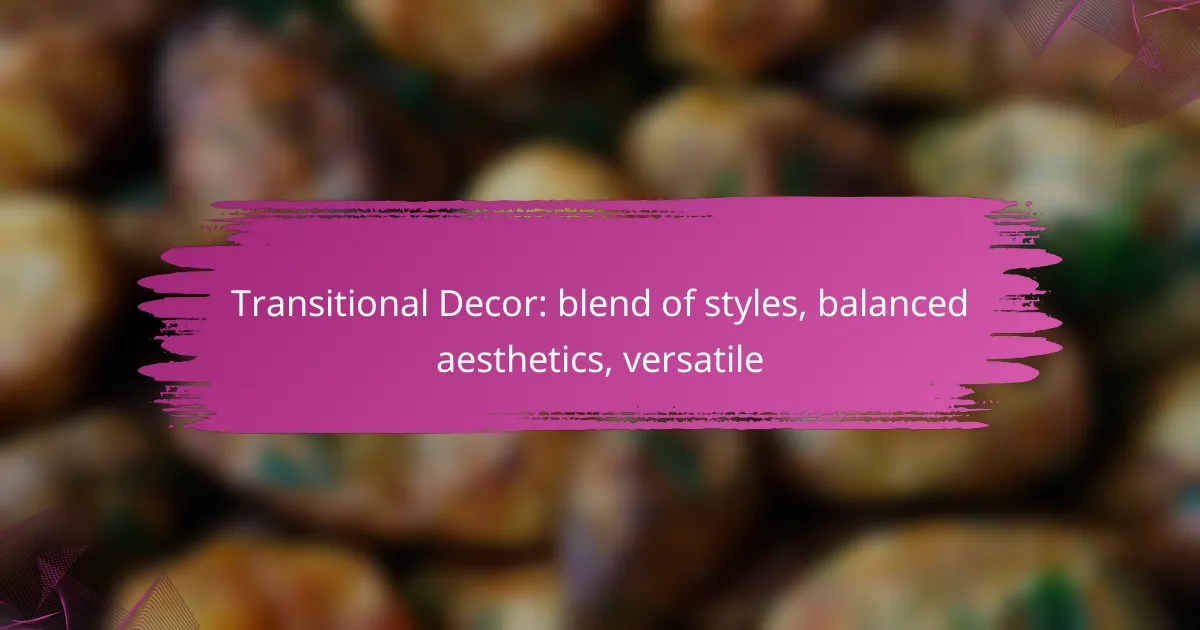Transitional decor seamlessly blends modern and traditional styles, resulting in a balanced aesthetic that appeals to diverse tastes. This versatile approach allows homeowners to mix various design elements while ensuring a cohesive and inviting atmosphere. By focusing on comfort and functionality, transitional decor creates stylish spaces that feel both timeless and contemporary.

How to incorporate transitional decor in Canadian homes?
Incorporating transitional decor in Canadian homes involves blending modern and traditional styles to create a balanced aesthetic. This approach emphasizes versatility, allowing homeowners to mix various elements while maintaining a cohesive look.
Mixing modern and traditional elements
To effectively mix modern and traditional elements, start by selecting key pieces from each style that complement one another. For instance, pair a contemporary sofa with a classic coffee table to create visual interest. Aim for a harmonious balance by ensuring that the colors and materials of both styles work together.
Consider incorporating modern art pieces alongside traditional framed photographs. This juxtaposition can highlight the strengths of both styles, creating a unique focal point in your space.
Using neutral color palettes
Neutral color palettes are essential in transitional decor, as they provide a versatile backdrop that allows for easy mixing of styles. Shades like beige, gray, and soft whites can unify different elements, making the space feel cohesive. You can add depth by incorporating varying tones and textures within this palette.
To enhance the neutral base, consider adding pops of color through accessories like cushions or artwork. This approach keeps the overall look fresh and inviting without overwhelming the senses.
Choosing versatile furniture
Selecting versatile furniture is crucial for transitional decor. Look for pieces that can serve multiple functions, such as a coffee table with storage or a sofa bed for guests. This flexibility allows you to adapt your space to different needs without sacrificing style.
When choosing furniture, prioritize quality and timeless designs that can withstand changing trends. Investing in well-crafted items ensures longevity and enhances the overall aesthetic of your home.
Layering textures
Layering textures adds depth and interest to transitional decor. Combine materials like wood, metal, and fabric to create a rich visual experience. For example, a plush area rug can soften a hardwood floor, while metal accents can introduce a modern touch.
Don’t hesitate to mix different textiles, such as linen, velvet, and cotton, in your cushions and throws. This variety not only enhances comfort but also contributes to the overall warmth of the space.
Integrating natural materials
Integrating natural materials is key to achieving a balanced transitional look. Wood, stone, and plants can bring an organic feel to your decor, grounding the modern and traditional elements. Consider using reclaimed wood for furniture or accents to add character and sustainability.
Incorporating greenery through potted plants or floral arrangements can also enhance the natural aesthetic. Choose low-maintenance plants that thrive in Canadian climates, such as snake plants or pothos, to keep your decor fresh and lively.

What are the key characteristics of transitional decor?
Transitional decor combines elements from both traditional and contemporary styles, creating a balanced aesthetic that appeals to a wide range of tastes. This design approach emphasizes comfort and functionality while maintaining a cohesive look that is both inviting and stylish.
Balanced aesthetics
Balanced aesthetics in transitional decor arise from the harmonious blend of classic and modern elements. This style often features neutral color palettes accented by bold hues or textures, allowing for visual interest without overwhelming the space. For instance, a room may showcase a traditional wooden coffee table paired with sleek, modern chairs.
To achieve balance, consider using a mix of materials, such as soft fabrics alongside harder surfaces like metal or glass. This contrast enhances the overall appeal and ensures that no single style dominates the design.
Versatile style
The versatility of transitional decor makes it suitable for various settings, from urban apartments to suburban homes. This adaptability allows homeowners to incorporate personal touches while still adhering to a cohesive theme. For example, you can blend vintage accessories with contemporary art pieces to create a unique yet unified look.
When selecting furnishings, opt for timeless designs that can easily transition between different styles. This approach not only enhances versatility but also ensures longevity in your decor choices.
Functional design
Functional design is a cornerstone of transitional decor, prioritizing practicality without sacrificing style. Furniture pieces are often chosen for their usability, ensuring that spaces remain livable and comfortable. For instance, a sectional sofa can provide ample seating while maintaining a sleek profile that complements the overall aesthetic.
Incorporate multi-functional items, such as ottomans that serve as both seating and storage, to maximize space efficiency. This focus on functionality helps create environments that are not only beautiful but also serve the everyday needs of their inhabitants.

Which furniture brands offer transitional decor options?
Several furniture brands specialize in transitional decor, blending traditional and modern styles for a versatile aesthetic. Notable options include Wayfair, West Elm, and CB2, each offering unique selections that cater to diverse tastes and budgets.
Wayfair
Wayfair is known for its extensive range of transitional decor options, featuring a variety of furniture styles that can suit any home. With thousands of products available, customers can find everything from sofas to dining tables that balance classic and contemporary elements.
When shopping at Wayfair, consider using filters to narrow down your search by style, color, and price range. This can help you quickly locate pieces that fit your transitional decor vision without overwhelming choices.
West Elm
West Elm offers a curated selection of transitional furniture that emphasizes clean lines and natural materials. Their pieces often incorporate mid-century modern influences, making them ideal for those looking to create a stylish yet comfortable environment.
Keep an eye out for West Elm’s seasonal sales, which can provide significant discounts on popular items. Their commitment to sustainability also means many products are made from responsibly sourced materials, appealing to eco-conscious consumers.
CB2
CB2, a sister brand of Crate and Barrel, focuses on modern design with a transitional twist. Their furniture often features bold colors and innovative shapes, making it a great choice for those who want to make a statement while maintaining a balanced aesthetic.
When exploring CB2’s offerings, consider their accent pieces, such as lighting and decor items, which can enhance your transitional style without overwhelming your space. Their frequent collaborations with designers also introduce fresh, limited-edition items that can add unique flair to your home.

How to choose colors for transitional decor?
Choosing colors for transitional decor involves selecting a balance of neutral tones and accent colors that create a cohesive look. Focus on blending styles while ensuring the colors complement each other to achieve a harmonious aesthetic.
Neutral tones
Neutral tones are the foundation of transitional decor, providing a versatile backdrop that allows other elements to shine. Colors like beige, gray, and soft whites create a calming environment and can be easily paired with various styles.
When selecting neutral tones, consider the undertones—warm or cool—as they can drastically affect the overall feel of the space. For example, warm beiges work well with earthy accents, while cool grays may suit more modern furnishings.
Accent colors
Accent colors add personality and vibrancy to transitional decor. Choose a few key colors that resonate with your overall theme, such as muted blues, greens, or rich jewel tones, to create focal points in the room.
Limit your accent colors to two or three to avoid overwhelming the space. Use these colors in accessories like cushions, artwork, or decorative items to tie the room together without compromising the neutral base.
Color harmony
Achieving color harmony in transitional decor requires careful consideration of how colors interact. Use the color wheel to identify complementary or analogous colors that work well together, ensuring a balanced aesthetic.
Testing paint samples in the actual space can help visualize how colors change with lighting throughout the day. Aim for a cohesive look by ensuring that the chosen colors flow seamlessly from one area to another, enhancing the overall design.

What are the benefits of transitional decor?
Transitional decor combines elements from both traditional and contemporary styles, creating a balanced aesthetic that appeals to a wide audience. This approach offers numerous benefits, including timeless appeal, flexibility in styling, and enhanced comfort.
Timeless appeal
Transitional decor is characterized by its ability to remain stylish over time, blending classic and modern elements seamlessly. This timeless quality means that spaces designed with this style can adapt to changing trends without requiring complete overhauls.
For instance, a room featuring a mix of sleek furniture and traditional textiles can maintain its relevance for years. This approach allows homeowners to invest in decor that won’t quickly go out of style, making it a cost-effective choice in the long run.
Flexibility in styling
The versatility of transitional decor allows for a wide range of styling options, accommodating various tastes and preferences. Homeowners can easily mix and match different pieces, creating a personalized space that reflects their unique style.
For example, you might pair a modern sofa with vintage artwork or incorporate contemporary lighting fixtures in a room with classic furniture. This flexibility enables you to update your decor gradually, ensuring that your space evolves without losing its cohesive look.
Enhanced comfort
Transitional decor emphasizes comfort by combining functional elements with aesthetic appeal. This style often features soft textures, inviting colors, and ergonomic furniture, making spaces feel warm and welcoming.
To enhance comfort, consider using plush fabrics like cotton or linen for upholstery and incorporating layered lighting to create a cozy atmosphere. By prioritizing comfort alongside style, transitional decor ensures that your home is not only visually pleasing but also a relaxing retreat.
